Horse Dental Care: From Exams to “Floating” to Extractions
By: Dr. Lydia Gray
Why Your Horse Needs Dental Care
Vaccinations, parasite control, hoof care . . . these are routine wellness services we provide our horses with nowadays and dental care is an important part of this package. When we domesticated horses - began keeping them in confined spaces in close proximity to other horses, asked them to work or perform under excessively hard or soft surfaces, and changed their feed and feeding schedule – we created ideal conditions for diseases, parasites, uneven hoof wear, and irregular mouth patterns. Therefore it’s our responsibility to prevent each of those issues from affecting the health, comfort, and performance of our equine partners.
Descriptions of horse teeth and why regular oral examinations and dental corrections are needed can quickly get complicated, especially when fun words like hypsodont, malocclusion, periodontal, diastemata, and others are used. The main thing to understand is that the equine tooth continually erupts throughout the lifetime of the horse to account for being worn down by chewing. This sets horses up for all kinds of alignment and other issues that can affect not just the teeth but also the gums, cheeks, tongue, bone, and other tissues and structures. The good news is that regular, thorough, and documented veterinary examinations of the head and mouth can serve as an “early warning system,” detecting potential problem spots while they can still be corrected and before they become permanent, major problems. The saying “an ounce of prevention is worth a pound of cure” was probably first used to describe dental disease!
Equine Teeth Basics: The horse’s mouth
Although few have this many, horses actually have the capacity for 44 teeth by the time they’re an adult! If we just consider the teeth on the top, there are:
- 6 incisors
- 2 canine teeth (1 left, 1 right)
- 2 “wolf” teeth (1 left, 1 right)
- 6 cheek teeth (3 premolars and 3 molars) on the right
- 6 cheek teeth (3 premolars and 3 molars) on the left
- 22 teeth TOTAL on the top
Double this to include the bottom arcade for a grand total of 44 teeth in the mouth of an adult horse. Now let’s talk about each type of tooth individually:
Incisors are the teeth in the front that horses use to bite or tear off grass. While each tooth has a designated “official number”, these teeth may be referred to as central, intermediate, and corner incisors. All horses have the same number of incisors, 12 total (6 on the bottom and 6 on the top).
Canine or “bridle” teeth, also called tusks, are the individual teeth more often seen in geldings and stallions that lie in the interdental or bit space between the corner incisor and the first cheek tooth. Since horses are herbivores or grazing animals, not meat eaters, it is believed the only function of these teeth is for fighting between males of a herd. Canines are not present in every horse, even males.
“Wolf” teeth, the true first premolar, come next, and typically sit right next to the first large cheek tooth aka second premolar. They do not appear in every horse, may occur only on the top or bottom arcade (or only on the left or right), and may be present but not visible because they did not erupt through the gum (known then as “blind” wolf teeth). Wolf teeth come in all shapes and sizes but are typically much smaller than any of the other teeth. Wolf teeth that are abnormally positioned and may cause bitting issues are extracted, but many performance horses do just fine with normal wolf teeth.
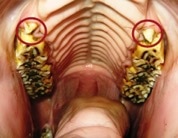
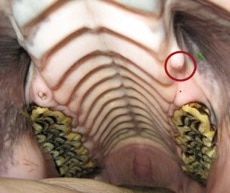
Premolars and Molars together make up the horse’s cheek teeth, the largest teeth in the mouth whose table surfaces meet in a sideways motion to grind food into smaller particles that can be swallowed and digested. All horses have three premolars followed by three molars in each arcade, right and left, top and bottom, for a total of 24 cheek teeth. Because the upper jaw is slightly wider than the lower jaw, the upper and lower cheek teeth don’t meet together perfectly – the upper cheek teeth protrude on the cheek side or outside of the mouth while the lower cheek teeth protrude on the tongue side or inside of the mouth. It is in these areas that sharp enamel points develop as the teeth wear, and these points can cause discomfort secondary to abrasions and ulceration to the cheeks and the tongue.
Incisors have traditionally been used to “age” a horse, although more and more the accuracy of this technique has been called into question. However, because most horses have all of their adult teeth by the age of five years old, it is somewhat possible to estimate the age of a horse from birth to five years. This table provides a general eruption or appearance schedule of the horse’s deciduous (baby or “milk” teeth) as well as permanent or adult teeth:
| Deciduous teeth | Permanent teeth |
| 1st incisors (centrals): birth to first week | 1st incisors (centrals): 2 ½ years |
| 2nd incisors (intermediates): 4-6 weeks | 2nd incisors (intermediates): 3 ½ years |
| 3rd incisors (corners): 6-9 months | 3rd incisors (corners): 4 ½ years |
| 2nd premolars: birth to first 2 weeks | 2nd premolars (1st cheek teeth): 2 ½ years |
| 3rd premolars: birth to first 2 weeks | 3rd premolars (2nd cheek teeth): 3 years |
| 4th premolars: birth to first 2 weeks | 4th premolars (3rd cheek teeth): 4 years |
| None | 1st molars (4th cheek teeth): 9 to 12 months |
| None | 2nd molars (5th cheek teeth): 2 years |
| None | 3rd molars (6th cheek teeth): 3 ½ to 4 years |
| None | Wolf teeth (1st premolars): 5 to 6 months |
| None | Canines (bridle teeth): 4 to 5 years |
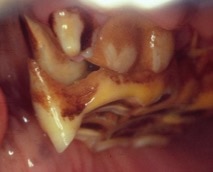
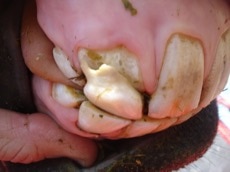
Although it is important to note that not every horse “reads the book” and therefore eruption ages may vary, many horsemen use the saying “6 days, 6 weeks, 6 months” to remember how old foals and weanlings generally are when their deciduous incisors come in. Likewise, “2 ½, 3 ½, and 4 ½” is an easy way to remember when the permanent incisors come in.
Routine Dental Care in Horses
According to the American Association of Equine Practitioners or AAEP, all horses should receive a veterinary oral and dental examination at least annually. For horses less than 5 years of age, over the age of 20, and those with known dental problems, more frequent visits may be necessary. This is because young horses are undergoing dramatic changes in the mouth as their full complement of adult teeth emerge, senior horses are at a greater risk for developing dental disease as teeth and other structures change shape and stability with age, and all horses have a better chance of maintaining their general health, productivity, and longevity if previously diagnosed issues are kept on top of.
Based on the findings of the dental exam, a preventive plan to maintain proper dental alignment and/or a treatment plan to manage or correct any existing oral condition will be recommended. The proper bite and chewing surfaces can be maintained in most horses with a procedure known as “floating,” in which the practitioner smooths sharp points from the cheek teeth with a combination of hand tools that look like rasps and files along with motorized equipment. Intravenous sedation is typically required for both the oral examination as well as the floating, since the insertion of a full-mouth speculum to hold the horse’s mouth open helps the veterinarian see, feel, and care for the teeth safely and efficiently.
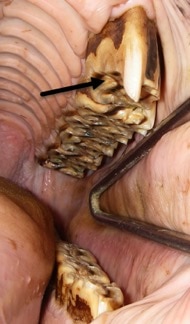
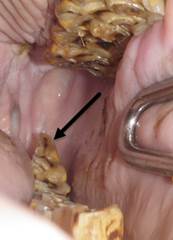
Common Equine Dental Issues
Given that the horse has two sets of teeth (deciduous and permanent) that erupt over a five-year period, that the cheek teeth don’t meet perfectly, and that even the permanent teeth continue to erupt over the lifetime of the horse, it should not be surprising to learn that horses come with built-in dental problems. Some of the most common include:
- Retained caps (deciduous teeth that are not shed at the right time)
- Sharp points on the cheek teeth, which can cause cuts of the cheek and tongue
- Misalignment affecting individual teeth (called hooks, ramps, steps, and waves)
- Lost and/or fractured teeth
- Excessively worn teeth
- Abnormally long teeth
- Infected teeth and/or gums
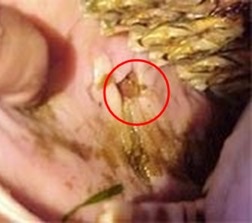
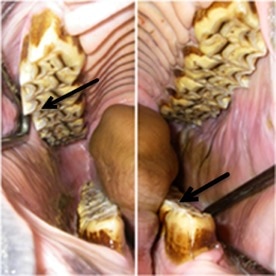
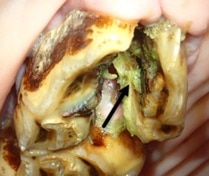
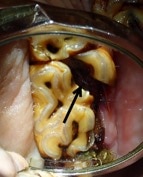
Rather than waiting until a horse is displaying obvious signs of oral pain or discomfort, or is exhibiting difficulty grasping or chewing food, schedule regular examinations of the mouth and related structures. This will not only help prevent dental disease in the first place but also lead to the treatment of issues as early as possible, avoiding more serious and costly care down the road. With routine dental examinations followed by appropriate care and corrective work, many horses will maintain happy teeth and gums into their 30s and 40s.
Photos Courtesy of Dr. Leah Limone, Northeast Equine Veterinary Dental Services, Topsfield, MA
SmartPak strongly encourages you to consult your veterinarian regarding specific questions about your horse's health. This information is not intended to diagnose or treat any disease, and is purely educational.